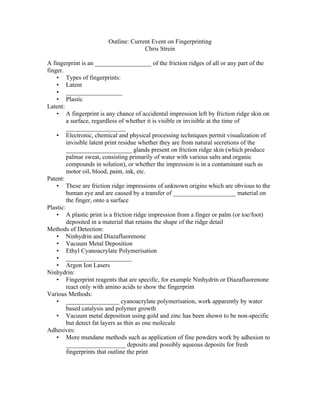
Outline For Fingerprinting: Chris Strein
- 1. Outline: Current Event on Fingerprinting Chris Strein A fingerprint is an __________________ of the friction ridges of all or any part of the finger. • Types of fingerprints: • Latent • __________________ • Plastic Latent: • A fingerprint is any chance of accidental impression left by friction ridge skin on a surface, regardless of whether it is visible or invisible at the time of ___________________ • Electronic, chemical and physical processing techniques permit visualization of invisible latent print residue whether they are from natural secretions of the _____________________ glands present on friction ridge skin (which produce palmar sweat, consisting primarily of water with various salts and organic compounds in solution), or whether the impression is in a contaminant such as motor oil, blood, paint, ink, etc. Patent: • These are friction ridge impressions of unknown origins which are obvious to the human eye and are caused by a transfer of ____________________ material on the finger, onto a surface Plastic: • A plastic print is a friction ridge impression from a finger or palm (or toe/foot) deposited in a material that retains the shape of the ridge detail Methods of Detection: • Ninhydrin and Diazafluorenone • Vacuum Metal Deposition • Ethyl Cyanoacrylate Polymerisation • _____________________ • Argon Ion Lasers Ninhydrin: • Fingerprint reagents that are specific, for example Ninhydrin or Diazafluorenone react only with amino acids to show the fingerprint Various Methods: • _________________ cyanoacrylate polymerisation, work apparently by water based catalysis and polymer growth • Vacuum metal deposition using gold and zinc has been shown to be non-specific but detect fat layers as thin as one molecule Adhesives: • More mundane methods such as application of fine powders work by adhesion to ___________________ deposits and possibly aqueous deposits for fresh fingerprints that outline the print
- 2. • Argon Ion lasers use a wide range of fluorescence techniques primarily for the enhancement of chemically developed fingerprints but also for some detection of inherent fluorescence of the ________________ fingerprints DNA vs. Development: • Fingerprint Development like the traditional methods just explained have a downside though. In fact, the chemical methods have multiple downsides. The chemistry of the fingerprint is destroyed or altered during the process of development and forensics have issues in obtaining the DNA of the fingerprint. Also, the methods rely on specific substances and sometimes are not effective based on the traces left. The New Method: • The method was developed at Penn State University and is being patented by professors Robert ___________________ and Ahklesh Lakhtakia via provisional patent application for the process • “The process is called conformal-evaporated-film-by-rotation, and was originally developed to create highly-detailed copies of biological surfaces such as insect eyes or butterfly wings. It utilizes a form of physical vapor deposition where materials are heated in a vacuum, causing them to vaporize and then condense on the surface of an object rotating above them, covering that object in a thin film.” • “In the case of Penn State’s technique, the materials that they heated were _______________ ___________________ and chalcogenide glass, which is a combination of germanium, antimony and selenium. The film created was only about one micron thick, but that was enough to essentially “amplify” the ridges and valleys of fingerprints, allowing analysts to read them with an optical device.”